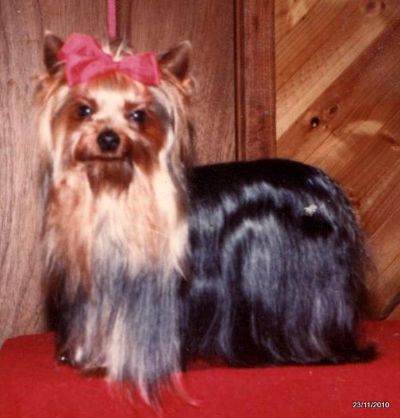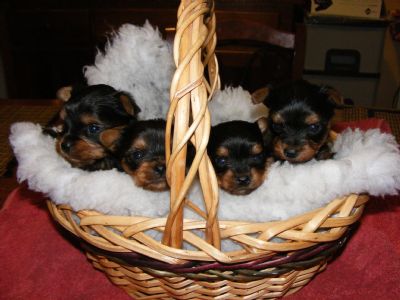Breed Information Sheet

Pictured Australian Champion Ancrownes Gold Seal
AN INTRODUCTION TO THE YORKSHIRE TERRIER
By Jospehine Eatts Buidhe Yorkshire Terriers
The tiny Yorkshire Terrier, with his engaging personality and dauntless courage has endeared himself to pet lovers everywhere. He is possessed of great intelligence, is very trainable, and makes an admirable watchdog with the characteristic fearlessness and tenacity of the breed.
HISTORY OF THE YORKSHIRE TERRIER
Small terriers, long since vanished from the homes and hills of Scotland, are considered forbears of our delightful breed. The Waterside Terrier was developed by the mid-1700's by country folk to keep homes safe from rats and other vermin. Small terriers, such as the now extinct Clydesdale or Paisley Terrier, the Skye Terrier, and the black and tan English Terrier, are possibly ancestors. Later called Scotch Terriers, they moved, with their Scotsmen owners, south to Yorkshire for work. Breed development continued, and the pretty blue and tan Yorkshire Terrier, as it is known today, was finally recognised by the Kennel Council of England as a breed.
Born in 1865, Huddersfield Ben, regarded as the Father of the Breed, was the first registered Yorkshire Terrier in the United Kingdom. The first Yorkshire Terrier known to have been in Australia was "Punch," exported to Brisbane. from England around 1872 by Mr J Spink. "Punch", was a close relative of Huddersfield Ben. From that time the breed has made its mark in the Dog World of Australia.
WHAT IS A YORKSHIRE TERRIER?
It must never be forgotten that a dog is a living creature. A Yorkshire Terrier will require as much time and care as a small child, especially in view of its small size.
- The Yorkshire Terrier is a Toy breed. generally known as "A giant character in a small dog."
- The Yorkshire Terrier is a hardy little dog with a great zest for life.
- The Yorkshire Terrier has an appetite for long tireless walks, but is equally at home with the alternative ability to exercise himself in reduced space. Furthermore, the diminutive size makes the Yorkshire Terrier a first rate choice of pet in today's condensed living space.
- The Yorkshire Terrier has a great deal to offer the pet owner as a grand companion, a cuddly lap dog, a noisy watch dog and a great entertainer.
- Owning a Yorkshire Terrier is a commitment for up to 15-17 years.
THE YORKSHIRE TERRIER'S COAT
The most outstanding feature of the Yorkshire Terrier, distinguishing him from all other small breeds, is his long, silken textured coat. It should be remembered, however, that this lustrous coat can and will look its best only with constant grooming and attention from the owner.
The glossy silky coat is very similar to human hair in that it continues to grow and requires trimming. It does not shed. The coat should be brushed daily, and shampooed regularly, to maintain a healthy shiny coat.
The pet owner who has neither the time nor the inclination to give his charge the necessary daily brushing would be well advised to trim the coat to a manageable length and maintain it this way. This provides a short carefree and clean coat which still requires grooming, but is much easier to manage.
THE YORKSHIRE TERRIER BREEDER
A concerned breeder studies the Breed Standard set down for the Yorkshire Terrier and carefully plans a litter to maintain and improve their dogs.
Dedication to improvement of their breed should be the reason for breeding and participating in competition in the showring. The breeder then becomes known in the Dog Fancy and has a reputation to protect.

MAKING THE CHOICE
Before making the decision to purchase a Yorkie puppy, a prospective buyer should make every effort to learn as much about the breed as possible, thus ensuring an awareness of the responsibilities that go with owning a Yorkshire Terrier. It is advisable to visit as many dog shows as are available and discuss the purchase with breeders and exhibitors. Most are only too pleased to offer any advice or information relevant to the acquisition of a puppy.
After gaining a basic awareness of the characteristics of the breed and a realisation of their own requirements, a buyer should next approach a registered breeder and state honestly and exactly the type of puppy they are interested in owning.
CHOOSING A YORKSHIRE TERRIER PUPPY
When choosing a puppy, temperament and soundness are all important. A puppy with a happy and fearless disposition that plays happily with his litter mates and does not shrink from the approach of strangers will give a lifetime of happiness. It should have bright sparkling eyes free from discharge, and a firm body that can be plump, but not bloated, with a glossy coat and healthy skin.
Both dog and bitch are equal in intelligence and companionship. Dogs may take a little longer to house train, and a bitch will require extra care while in season, which generally occurs every 6-8 months. If you are not intending to breed, it is always advisable to have your bitch desexed, and your veterinarian will advise when this should be carried out.
The difference between a show quality puppy and the rest of the litter is very minimal and relates to such factors as perhaps the size of the ears, the colour of the pigment, size of the puppy, and so forth. It is not often possible, at a very early age, to determine what the colour of the coat of an adult Yorkshire Terrier will be, but this is also an important factor when choosing a show ring prospect. Therefore, a breeder will often "run a puppy on" for some months before the final decision as to its showability is made.
TAKING CARE OF A YORKSHIRE TERRIER
Feeding
The Yorkie has a reasonably small appetite, and a large tablespoon of food for each meal usually satisfies. Puppies and growing dogs require more food a day than the fully grown dog. Four meals a day are necessary when young. When fully mature, one, or at the most two, meals a day are sufficient. Whatever food is given must be well balanced and wholesome,
Health, development and care
Yorkshire Terriers are a healthy breed, with very slight incidence of inherited disorders amongst the breed in Australia. Luxating patella (slipping kneecaps) can be an inherited problem.
It is important that owners recognise that a Yorkshire Terrier is a very active dog and will expend vast amounts of energy running around jumping up and down on and off furniture, leaping much higher than it's height, therefore putting stress on, particularly it's back legs. This environmental aspect can lead to Luxating patellas - too much exercise too soon in a young dog.
General advice on caring for your puppy's eyes, ears nails, coat and dental care should be supplied to you by the breeder of your Yorkshire Terrier.
The health of your new puppy is important, and your responsibilities include a follow-up on your puppy’s first vaccination which should have been carried out by the breeder’s veterinarian when the puppy was 6-8 weeks of age. When you purchase your puppy, you can expect to receive from the breeder a veterinary record of its vaccination history, which also gives the due date of puppy’s next vaccination.
Obtaining your puppy from a Registered Breeder ensures that follow-up about the care of your puppy’s every day needs is readily available – a single phone call is all that’s needed.
Should the puppy have the misfortune to develop any kind of serious hereditary defect, the breeder with a reputation to consider will want you to discuss the problem with them.

Pictured Australian Champion Whingate Little Dandy
Owner Josephine & Libby Eatts / Handler Josephine Eatts